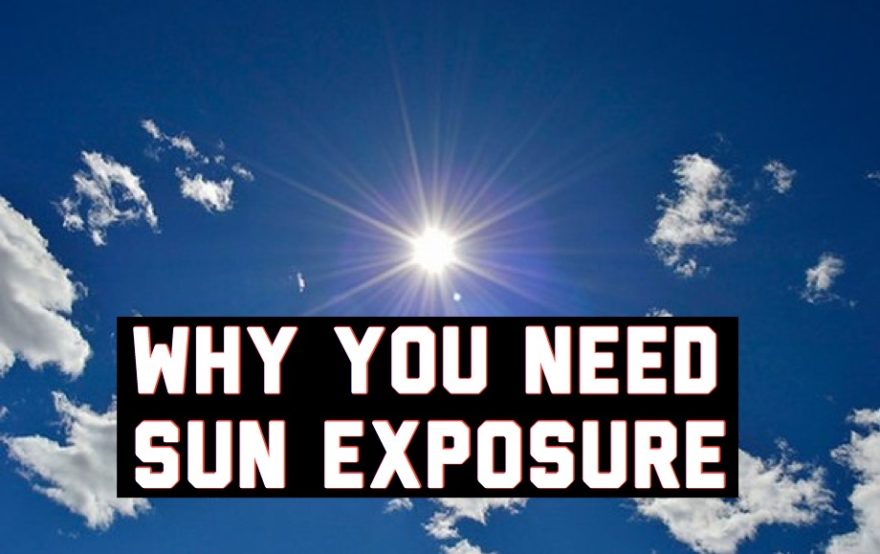Do you get out in the sun at all? Increasing my sun time has done wonders for my energy and sleep levels, and it’s an area we probably don’t hear enough about.
That’s why I brought my buddy/fam/mentee/amazing Canadian physio Iordan Krouchev to teach y’all about all things related to sun exposure. In this post, he educates you about how to safely be out in the sun, and dispels many common myths surrounding the sun.
Read this, enjoy, follow Iordan on Facebook, and get outside afterwards 🙂
Table of Contents
All praise the sun
For eons, humanity has worshipped the sun very well knowing that without “it”, there would be no “us”.
Helios, son of the Titans Theia and Hyperion, drove his fiery chariot from East to West every single day keeping Homer, Socrates and all our other beloved philosophers alive. As much as the sun was venerated, its power was also feared. Losing control over the chariot, Helios’ son Phaethon set the Earth on fire and was quickly struck down by Zeus killing him on the spot in order to avoid the end of mortals.

We now know that nor Helios, Ra, Belenus (Celtic), Xihe (Chinese; she also almost led to everything burning) or Surya (Hinduism) are the source of light and life on our planet. However, the fascination, adoration and fright of our ancestors of all cultures was well justified. Without the sun, or with changes in its activity, life as we know it would likely cease.
Fast forward to 2018. On one side, asking someone if the sun is important would likely lead to a “no shit” answer. On the other, those same people often flee from it and talk about all the bad things it does to us.

Since the industrial revolution, the rapid development of technologies and ways to constantly live more comfortably has led us to an odd place. We can spend full days and weeks in the “light” with no actual direct sunlight. We can spend months without contact with our environment or with the changing seasons. For a system (the human body) that’s always been under the sun and its rhythm dictated by the sun and the seasons, it’s a huge “evolutionary mismatch”.
Overall, we are talking about ways to cope with man-made environments that do not fully meet the system’s requirements, as determined through millennia of adaptation to the natural and social surroundings. This mismatch increases as culture and technology evolve more rapidly than our biology.
We could talk about:
- Lack of physical activity and sensory stimuli
- Persistent, low grade psychological stress
- Excessive availability of low nutrient, high energy dense foods coupled with decreased variability in the foods we consume (mangos shouldn’t exist in Montreal’s winter)
- Social isolation
But today our main point of discussion revolves around the lack of sun exposure, which some call “mal-illumination”. This video, shared by Éric R. Lépine is what triggered this interest a few months ago, so I invite you to take a few minutes to watch:
So, why should we expose ourselves to the sun?
Risks and benefits of sun exposure

Sunburns vs sun exposure
As the ancients knew, there is something to be feared from the sun.
Sunburns are associated with a twofold increase in the risk of melanoma. However, non-burning sun exposure is associated with a reduced risk of this aggressive cancer, so, surprisingly, indoor workers have a higher incidence of melanoma… Ultraviolet B (UVB) radiation is known to induce DNA damage through oxidative stress. However, many of the cellular mechanisms that repair and protect us from this damage are related to vitamin D, which is produced by UVB exposure. Sunscreen, on the other hand, has shown mixed results regarding reduction of the risk of melanoma.
Nonmelanoma skin cancers (basal cell and squamous cell carcinomas) have shown a potential increase in risk with increased sun exposure. This link isn’t however completely clear. These cancers are most prevalent in the face, neck as well as the back of the hands, potentially as those areas are usually more exposed to the sun.
We’ll explore vitamin D in more detail, but there are benefits to sun exposure unrelated to vitamin D. Multiple studies show a link between sun exposure and decreased risk of prostate cancer, non-hodgkins lymphoma and multiple sclerosis, independent of vitamin D.
UV radiation has been linked with reduced risk of obesity and type 2 diabetes as well as a reduction in blood pressure in hypertensive individuals.
In a Swedish study, avoidance of the sun was linked to a twofold increase in all-cause mortality.
Brains and sunlight
Sunlight affects the brains serotonergic activity. Deficiency in this activity is linked to a host of problems:
- sudden infant death syndrome
- seasonal affective disorder
- depression & schizophrenia
- Alzheimer disease
- migraines
Sun exposure also increase beta-endorphine levels, which leads to a feeling of wellbeing.
With adequate sun exposure “hygiene”, I believe the associate risk can be mitigated. But more on this later, as for now we’ll focus on vitamin D.
Vitamin D
In Canada, the United States and Europe, 20% to 100% of the elderly men and women are vitamin D deficient. In Boston, 50% of Hispanic and African-American adolescents and in Maine 48% of preadolescent Caucasian girls had levels below recommendations. This is also the case in Australia, the Middle East, India, Africa and South America.
Vitamin D is produced through exposure to sunlight and can also be ingested in our diet and through supplementation. Though diet and supplementation are useful, there are many sources that show that the effect isn’t quite the same as being exposed to the sun, because:
- Vitamin D is rare in most foods and cooking type, time and temperature may have a negative impact on vitamin D availability;
- Vitamin D synthesised in the skin lasts much longer in the bloodstream than when ingested
- It is stored in body fat and released during winter (when vitamin D cannot be produced).
Overall, supplementation or oral intake should be used but does not replace sun exposure.
So what’s vitamin D good for?
- Bones and muscles
Without vitamin D, very little calcium and phosphorous are absorbed, which can lead to bone density issues, osteopenia and eventually osteoporosis. This also reduces mineralization of the collagen matrix and leads to osteomalacia. Deficiencies in vitamin D also lead to muscle weakness and some studies show an increased risk of falling in the elderly!
- Cancer and infections
Vitamin D has an impact on most organs in the body and it controls more than 200 genes, including genes that regulate the proliferation, differentiation, apoptosis (programmed cell death) and other cellular functions. Reduced levels of vitamin D are associated with increased risks of colon, prostate, pancreas and breast cancer as well as a higher mortality rate from these cancers.
It’s also crucial for immune protection and destruction of infectious agents. It prevents infectious diseases and upper-respiratory tract infections, asthma and wheezing disorders.
- Autoimmune disorders
As vitamin D increases, the risk of developing multiple sclerosis, rheumatoid arthritis and Crohn’s disease decreases. Deficiency of vitamin D in children increases significantly the risk of type 1 diabetes.
- Cardiovascular and organ health
Risks of hypertension, coronary artery disease, heart failure and peripheral artery disease all gradually increase as vitamin D levels decrease. Vitamin D has a positive impact on stroke prevention, type 2 diabetes, periodontitis and tooth loss. Low levels of vitamin D have been linked to an increased insulin resistance and the metabolic syndrome.
A deficiency also leads to a higher level of inflammatory factors in the blood (C-reactive proteins and IL-10).
- Mental health
Vitamin D deficiency is linked to schizophrenia, depression, Alzheimer’s disease and dementia.
- Pain
Some studies show that increasing vitamin D leads to reduced pain related to fibromyalgia, low back pain, migraine and arthritis.

Let’s hope he wasn’t wearing this cape and armor during summer…
What affects vitamin D production through the skin?
Sunscreen
It seems to absorb some of the UVB radiation, which could lead to a reduction in vitamin D production, even at a fairly low sun protection factor. Properly applied, SPF 30 sunscreen would decrease synthesis by 95%. In any case, it is something to consider.
Skin pigmentation
Melanin which is present in more pigmented skin will also absorb some of the UVB rays, leading to up to 99% less synthesis of vitamin D.
Age
As age increases, there is less and less 7-dehydrocholesterol in the skin, which is the precursor to vitamin D synthesis in the skin.
Time and space: Season, latitude, time of day and altitude
Where the sun is relatively to us will change the number of UVB photons that get to our skin. UVB rays only enter our atmosphere when the sun is at least 30 degrees of the horizon. That’s why living above approximately the 33rd parallel means that during winter vitamin D production is minimal if not absent. That’s anything North of Phoenix, Arizona!
Weather conditions and pollution
Clouds and pollution reduce the amount of UV radiation that can get to us. However, it can still penetrate, which explains sunburns on a cloudy day!
Clothing
No need for details here.

Circadian rhythms
Our body functions with a daily rhythm in physiology and behavior. The circadian “clock” consists of a central clock (suprachiasmatic nucleus in the brain) as well as clocks in pretty much every tissue and organ system in the body.
Our central clock is mainly driven by the light going into our eyes. Remember our evolutionary mismatch theory? Well, since electricity, we’ve been playing with that cycle. As “contemporary cave dwellers”, many of us do not get sufficient light in the day and have too much at night.
Our circadian rhythm is paramount when it comes to health. The International Agency for Research on Cancer has classified shift work with circadian disruption as a probable carcinogen.
Disturbance in that rhythm is also associated with sleep issues, mood disorders, multiple sclerosis, cardiovascular disease, metabolic changes as well as several types of cancer and their growth, recurrence rate and prognosis.
Light exposure during the day also dictates the timing and amplitude of the nocturnal peak secretion of melatonin, which has an anti-oxidant effect as well as a crucial impact on sleep.
Now what?
So, what can we do about all this?
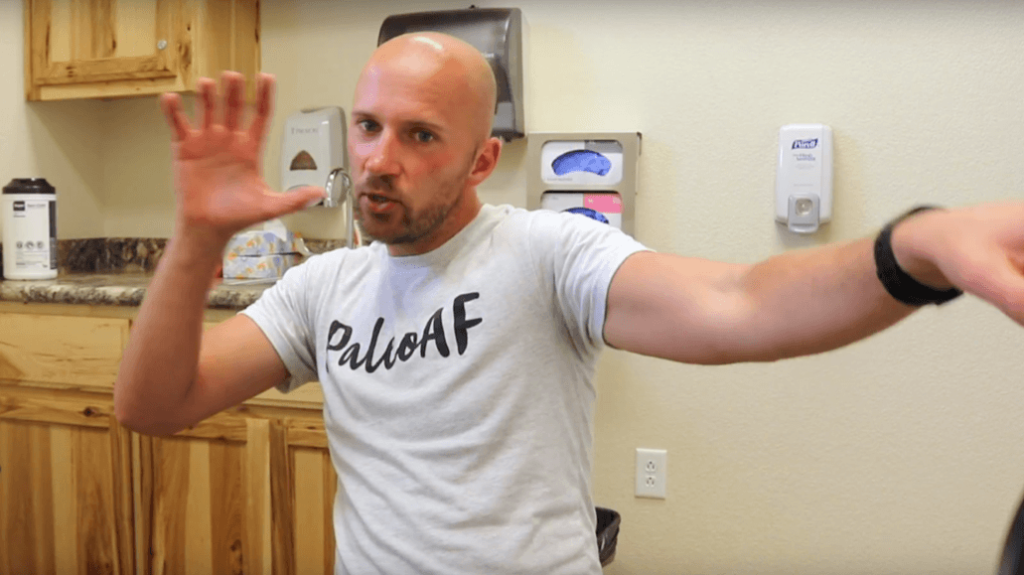
The first thing I’d like to stress is that there are risks associated to excessive sun exposure. However, chronic avoidance of the sun may very well lead to fragility on that front and a higher risk of burning with subsequent exposure.
Supplementation
Most guidelines recommend a blend of sun exposure and supplementation. Dr. Michael Holick recommends 5,000 to 6,000 units of vitamin D every day; other guidelines suggest that 1,000-2,000 IUs daily would be the lowest effective dose, which can be brought up to 20-80 IU/kg daily.
Sun exposure
Use sunscreen or cover your head, neck and the back of your hands or other commonly exposed areas. Try to expose the rest of your body to sunlight. In order to decide how much is enough, you can use the dminder app on your phone. This app helps you track how much vitamin D you are producing depending on factors we discussed above but, mainly, it tracks your sun exposure to avoid burning.
For manual people, first, find your skin type. Using the Fitzpatrick scale, there are 6 different skin types:
- Type 1: always burns, never tans (pale white; blond or red hair; blue eyes; freckles; some Scandinavians and Celts).
- Type 2: usually burns, tans minimally (white; fair; blond or red hair; blue, green, or hazel eyes; Northern European, Germans, some Scandinavians and Celts)
- Type 3: sometimes mild burn, tans uniformly (cream white; fair with any hair or eye color; Mediterranean and Middle East)
- Type 4: burns minimally, always tans well (moderate brown; East Asian and some Indians and Pakistanis)
- Type 5: very rarely burns, tans very easily (dark brown; African, South East Asians, some Indians and Pakistanis)
- Type 6: Never burns, never tans (deeply pigmented dark brown to darkest brown, African, dark-skinned Asians)
You can then use the following charts (adapted from Michael Holick’s “The Vitamin D Solution”)
Northern hemisphere latitude map

- Skin type in hand, find which zone your city is in (0-25; 25-35; etc)
- The tables are planned for an exposure of 25% (short sleeve + pants) to 50% (short sleeve + shorts) of your body’s surface
- The times in the tables are equivalent to 25% to 50% of 1 Minimal Erythemal Dose (amount of UV radiation that will produce sunburn or redness within a few hours following exposure)
- To be done 2-3 times per week
Sun exposure in tropical latitudes (0-25 degrees)
Cities/countries at or around the 25th parallel: Miami, Algeria, Luxor (Egypt), Doha, Dubai
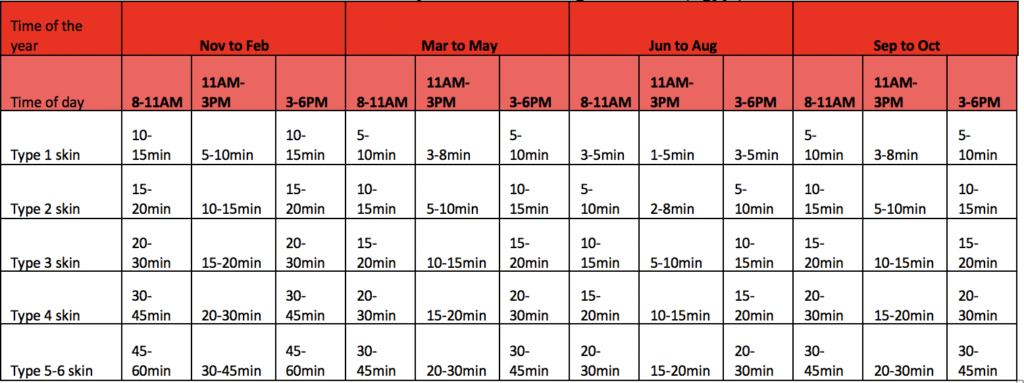
Sun exposure in subtropical latitudes (25-35 degrees)
Cities at or around the 35th parallel: LA, South two thirds of Arizona, Albuquerque, Oklahoma City, Memphis, Charlotte, Gibraltar, Crete, Cyprus, Tokyo
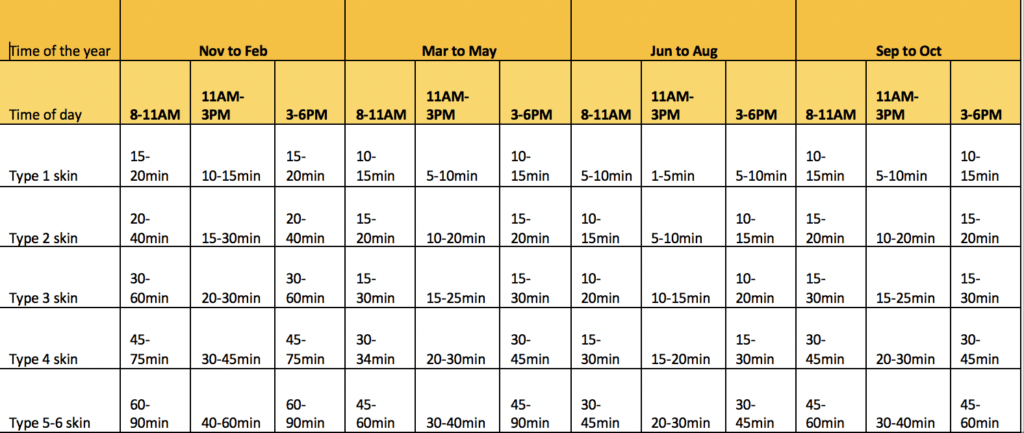
Sun exposure in midlatitudes (35-50 degrees)
Cities at or around the 50th parallel: Kelowna, Winnipeg, Sept-Îles, Frankfurt, Prague, Krakow, Kiev
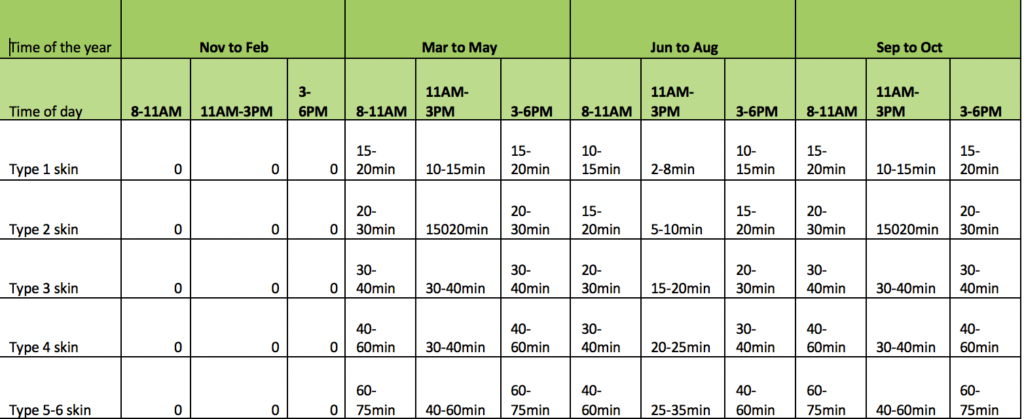
Sun exposure in high latitudes (50-75 degrees)
Cities above the 50th parallel: Edmonton, London, Warsaw
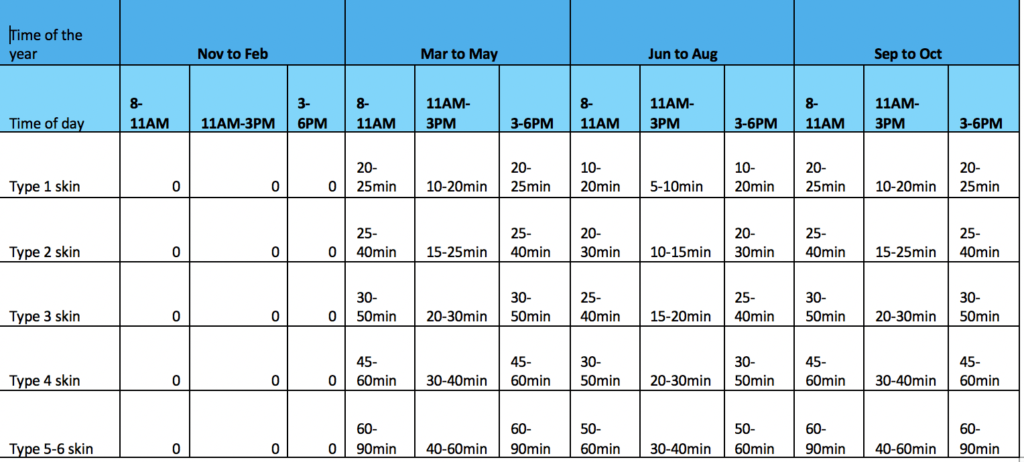
Whether using the app or the charts, start conservatively to avoid a sunburn. If you remain outside for longer, cover your skin with clothing or sunscreen (SPF 30).
Sleep-wake
As you wake up, get some light in your eyes. Ideally sunlight, although light therapy lamps could do as a substitute during winter when the sun rises late. Eating is also a driver for circadian regulation, so having breakfast soon after waking up is important!
Get some sun during the day! Whether under your winter gear, work suit or shorts and t-shirt, sun exposure is important, but so is sunlight stimulating your circadian clock.
Going out for a walk in the evening can also be a good way to tune-in to the day and night cycle as you will get exposed to the much warmer hues of the sunset.
At night, shut off as many lights as you can, use a blue-light filter such as F.Lux or sport some fancy blue-light blocking glasses if you need to stay awake past sunset. At this time of the day, eating late will also have a negative influence on your rhythm.
Lights out
To sum up, a healthy and frequent dose of sun exposure seems to be pretty important for life in general, as well as for health and performance. We could keep going on and on as to how these factors and many others influence our wellbeing and how they all crossover and impact one another, but we already have enough reason to get a few rays of suns in and justify the saying: “sun’s out, guns out” (with covered face and hands!).

About Iordan
Iordan Krouchev, M.Sc., CSCS Physiotherapist

Iordan completed his Bachelor’s and Master’s degrees in Physiotherapy at l’Université de Montréal where he focused on pain science, chronic pain, sport injuries and trauma. His passion for physical preparation and human movement has led him to seek hundreds of hours of continuing education in the fields of therapy, strength and conditioning as well as coaching. His treatment philosophy recognizes the emergent and holistic nature of pain and human movement. His clinical assessment is highly patient-centric, using a variety of perspectives and objective tests that allow him to find the root of the issue and not only treat the symptoms. Iordan’s individualized approach uses different tools to keep the person as active as possible while guiding the healing process to help the person recover from pain and enhance their movement potential.
You can reach him at iordan@corexcellence.com or through social media.
Selected references
http://press.endocrine.org/doi/10.1210/jc.2011-0385
https://www.ncbi.nlm.nih.gov/pubmed/27942349
https://www.ncbi.nlm.nih.gov/pubmed/24697969
https://www.ncbi.nlm.nih.gov/pubmed/17634462
https://academic.oup.com/jcem/article/95/2/471/2596417
https://academic.oup.com/ajcn/article/79/3/362/4690120
https://www.ncbi.nlm.nih.gov/pubmed/27676659
https://www.ncbi.nlm.nih.gov/pmc/articles/PMC2954516/
https://academic.oup.com/jcem/article-abstract/64/6/1165/2653261
The Vitamin D Solution, Michael Holick
Photo Credits

